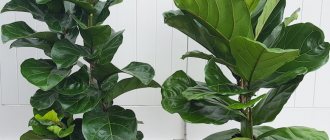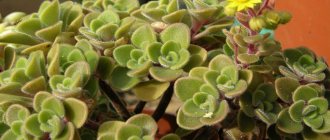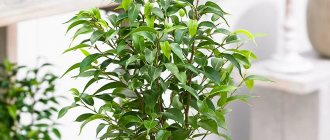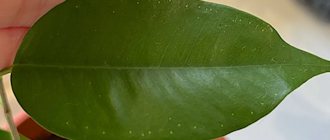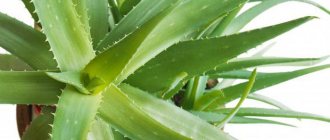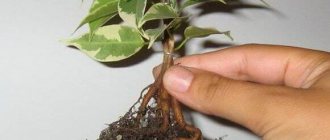In nature, ficus trees, among which there are trees, shrubs, and vines, often reach a height of several tens of meters, but through the efforts of breeders they have long been adapted for cultivation indoors. Ficus Melanie is a prime example of such a “tamed” exotic. Its distinctive feature is its compactness. The small size of this ornamental tree allows it to be grown even in extremely limited spaces.
By providing your ficus with proper care, you will grow a resilient, durable plant that can live for as long as fifty years!
What does Ficus Melanie look like, what family does it belong to?
This plant is so compact that it is suitable for cultivation in any room. Ficus variety Melanie has a beautiful crown. The densely planted leaves make the plant especially attractive.
Growing ficus rubber
The length of the leaf plates is about 13 cm. Their surface is glossy, and the reverse side, on the contrary, is matte. On a light green background you can see many reddish veins. The vertical option of growing the plant allows you to achieve large branching. Pruning will help give the bush any shape.
Common varieties
The most common varieties of rubber-bearing ficus are:
- Abidjan - the plant loves bright light, has oval leaves of a dark green color, pointed at the end.
- Belize - a feature of the variety is white and pink stains along the edges of the leaf plate.
- Melanie - this ficus has dense foliage, the length of the plate is 15 cm.
- Robusta - the variety is the most unpretentious, the leaf length is 30 cm, the shape is ellipsoidal.
- Black Prince - the foliage color of this variety is the darkest of all. The leaves are round, their shade changes in accordance with changes in the light in the room.
- Tineke is a variegated variety; along the edges of the foliage you can see a white or cream border.
- Shriveriana - ellipsoidal foliage has a marble color, the length of the plate is 25 cm and the width is 18 cm.
- Tricolor is a variegated variety, the foliage has an interesting marble pattern.
- Decor – dark green foliage with a burgundy tint, the length of the plate is 18 cm.
Ficus Shriveriana
Medicinal properties
The juice of this plant is good for hard-to-heal wounds and boils. Dry ficus leaves are used in the treatment of rheumatism and hemorrhoids. The leaves are also used in gynecology and oncology. Inflammatory processes can be easily relieved with a tincture of the plant's roots.
Briefly about the history of appearance
In one of the greenhouses in Holland, which is considered the birthplace of the plant, an interesting bush appeared, which mutated completely independently from the ficus elastica Decor. Scientists took cuttings for rooting. After propagation, the result was an excellent hybrid that retained the characteristics of the mother bush in full. This is how it turned out to isolate a new variety, which was given the name Melanie.
Ficus Melanie: home care
Ficus rubber - home care
The flower is not very demanding in care. Many errors in plant maintenance go unnoticed, but you should not completely ignore the main points of growing.
Temperature
A good air temperature range for Melanie is considered to be 18-30 degrees Celsius. The plant may die if the thermometer needle in the room drops to 12 degrees. The ideal temperature is considered to be 20-25 degrees Celsius.
Large sizes of ficus grown at home
Lighting
Ficus elastica Melanie does not tolerate direct sunlight, the lighting should be diffused. The ideal windows for growing plants are western or eastern. In winter, the bush may need additional artificial lighting. If there is not enough light, the leaves will begin to fall. If there is excess light and direct sunlight, burns will appear on the leaf plates.
Note! To make the crown symmetrical and beautiful, you need to turn the flower pot with different sides towards the light.
Watering
For this variety, sparse watering is preferable to abundant watering. There is no specific hydration schedule. It is better to focus on the condition of the soil in the pot. The soil should be dry, but it should not be allowed to dry out or crack. Watering should be carried out when the soil has dried to a thickness of 5 cm. In the summer season, several waterings per week are required, and in the winter, 1 watering every 10 days is sufficient.
Spraying
If the room temperature is higher than recommended or the air in the house is too dry, you need to periodically spray the ficus. To moisturize the crown, only cool, settled water (no more than 10 degrees) is suitable.
Humidity
The air where Melanie grows must be humidified. This plant does not tolerate dryness indoors. You can wipe the leaves daily and shower once a month. Frequent spraying will help moisten the air.
Priming
Experienced gardeners do not make soil with their own hands, but buy ready-made compositions for ficus plants. If it is not possible to purchase soil, you need to make the appropriate soil for the flower at home:
- slightly acidic or sour;
- moisture permeable;
- breathable.
When preparing the soil, you need to mix 1 part leaf soil, 1 part turf, 1 part humus and half a part river sand. Expanded clay or broken bricks are used as drainage.
Sale of ficus Melanie, suitable size for purchase
Feeding
During the growing season and active growth, the plant requires several feedings per week. Fertilizer can be used in the form of nettle decoction, wood ash or mineral compositions in liquid form. Fertilizers can be applied only to moist soil, preferably with watering or the next day after it. Next, fertilizing will be needed only a few times a year (once in warm weather and once in cold weather).
Important! You should not feed the ficus in the first month after planting it in its main place.
Microclimate
Anyone can grow ficus Melanie: these varieties of evergreen rubber trees are not considered particularly picky to care for. Nevertheless, you should still study the basic recommendations of experts.
Great attention should be paid to maintaining an optimal indoor microclimate. For example, lighting is vital for ficus
It should be moderately bright. It is best to place the pot with the plant on the east window.
It is not recommended to place a flowerpot in the southern part of the house, since direct sunlight in this case will burn the leaves. But there is no place for the plant in absolute shade. With a lack of sunlight, the foliage will gradually lose its brightness and begin to fade noticeably. As a rule, in winter you cannot do without additional lighting. Use special phytolamps that can support the full functioning of the rubber ficus.
Temperature plays an important role in creating an optimal microclimate for growing indoor ficus. In summer, it is desirable that temperatures do not go beyond 24–26 degrees, and in winter they can be lowered to 18–19 degrees. Remember: hot air streams can have a detrimental effect on indoor ficus. That is why in winter, try to keep your houseplant away from radiators and other heating devices.
Features of care in winter, rest period
Ficus benjamina - home care
Almost every ficus, when the temperature drops and there is a lack of light, goes into the sleep stage. If the optimal temperature regime is maintained in the room, that is, when the apartment is well heated, plant growth can continue. In this case, you need to use artificial lighting and monitor air humidity. If such conditions are not met, Ficus rubber Melanie will enter the stage of rest and sleep. In this case, it will drop its leaves. You will only need to maintain a cool temperature and occasionally water the plant, about once a month.
Beneficial features
Ficus Melanie is not only one of the interior decorations. It also has practical benefits. Its leaves are capable of absorbing vapors of phenol, benzene and trichlorethylene, which are emitted by plastic household items and furniture made from non-natural materials, thereby improving the health of the air in the apartment.
The leaves of rubber-bearing ficus trees are also used in folk medicine. For example, they apply it to boils at night so that pus comes out of them. Juice from Melanie leaves helps with hemorrhoids, some diseases of the female reproductive system, has an antiseptic effect and promotes wound healing.
It is believed that ficus should be purchased exclusively during the waxing moon, and be sure to give the donor something in return. A ficus received free of charge will bring trouble to the new owner. So thank the one who gives it to you, at least symbolically.
Trimming
Ficus lyre-shaped - home care
Ficus of this variety sheds its lower leaves during the ripening process. To maintain high decorative value, formative pruning is carried out at the end of winter. For good branching, you need to cut off the top of the ficus, and to increase the splendor of the bush, about five upper internodes are cut off.
An additional way to get a beautiful crown is to press the ficus as low to the ground as possible. In this case, the main bud will not be the apex, but the lateral bud. She will begin her active growth.
How does Ficus Melanie reproduce?
All ficus trees actively reproduce, and Melanie is no exception.
Germination of seeds
At home, the ficus Elastica Melanie does not bloom; for this reason, propagation of the shrub using seeds is impossible.
Rooting cuttings
Cuttings are prepared in the spring, but this can also be done in the summer. You need to cut off the top or side shoots. To make the cut take root faster, it is treated with Kornevin. You can root cuttings not only in soil, but also in water.
Air layering
Cuts are made on the trunk and secured with a sliver. Moss is wrapped around the cut and secured with film. In a month, roots will appear, and then the cuttings can be cut and placed in the ground.
Ficuses grown on a windowsill
Description of the plant
Melanie belongs to the rubber-bearing ficus and differs from its relatives in appearance. This is not a tree, but rather a shrub, which has the advantage of having a compact crown and can easily tolerate pruning. Its small size allows you to place the bush not only on the floor, in specially designated areas, but also on the windowsill.
Other features include:
- The direction of growth of the branches is not upward, like that of its relatives, but to the sides, which determined its similarity to a bush;
- The leaves are dense in structure, elongated with a sharp tip, which is slightly curved downwards. They can reach fifteen centimeters in length and seven in width;
- The outer side of the leaf is glossy, rich green, sometimes the shade can be darker. The inner part is lighter, matte and distinguished by the presence of red veins;
- The distance between the cuttings of each subsequent leaf is on average several centimeters;
- In indoor conditions it blooms very rarely. In the wild, you can see rather unremarkable flowers of pale shades, which are pollinated only by certain types of insects.
Melanie is a fruit-bearing plant, but has no nutritional value for humans. The fruits are small, no more than a centimeter in diameter and resemble tiny figs in appearance.
This rather remarkable plant is not demanding; even a novice gardener can take care of it.
Abundant branching opens up wide spaces for the imagination of lovers of original crowns.
Transfer
At a young age, ficus is replanted at least once a year. An adult plant needs to be replanted once every 3 years. To understand when to replant a ficus, you should pay attention to the roots. If they grow through the drainage holes of the pot, then the container is completely filled with the root system. Transplantation is carried out in the spring, using the method of transferring from a pot to another container along with a lump of earth. The remaining free space is filled with soil.
Important! It is not worth replanting a ficus from a small pot into a large one immediately. Otherwise, the root system will develop quickly, which will negatively affect the growth of the upper part of the plant.
Possible problems in cultivation and diseases
Although Ficus Melanie is highly resistant to many diseases, problems with its cultivation can still arise if you do not take care of it.
Drops buds and leaves
The reason for this condition is violations of the rules of care. Most likely, the ficus was either too flooded with water, or watering was carried out rarely. To eliminate the problem, you need to take care of the drainage layer and irrigate regularly.
The leaves are turning pale
Foliage may turn pale due to a lack of nutrients in the soil. In this case, the ficus needs to be fed urgently or wait until the period when the plant can be fertilized without threatening its development.
The tips of the leaves are drying out
This occurs due to increased dryness of the air. A container of water placed next to the pot will help solve the problem. It is important to carry out frequent spraying and moistening of the soil. It is useful to wipe the leaves with a damp cloth.
The tips of the leaves of the plant dry out
The lower leaves fall off
When a ficus drops its lower leaves, this does not indicate problems. In this way the plant is simply renewed. When the lower leaves fall off, a new top grows.
Pests
The most popular pests of ficus are thrips, spider mites and scale insects. Insects can be collected and destroyed manually or special preparations can be used to eliminate the possibility of larvae appearing.
Important! As a preventive measure against the appearance of pests, it is important to exclude severe dry air.
Other problems
If your ficus leaves turn dark and damp, this could be a sign of root rot. Most likely, the ficus was over-watered. Excessive watering needs to be eliminated, but in most cases it is not possible to save the bush.
Signs and superstitions
The Slavs have long believed that ficus in the house contributes to the development of such traits in the owners as envy, scandalousness and a tendency to gossip. There is also an opinion that ficus trees drive away a potential husband from a woman and do not allow him to get along in the house. Foreigners believe that this bush strengthens the family and has a beneficial effect on the atmosphere in the house.
Ficus Melanie is very popular among novice gardeners and experienced connoisseurs of such ornamental crops. Unpretentiousness in care and cultivation characterizes the bush only on the positive side.
Reproduction methods
Abidjan can be easily divorced:
- Rooting stem cuttings. The ficus trunk is divided into parts, each of which must contain at least one healthy leaf. The plates are cut in half or rolled into a tube and secured. Place in water until roots form or plant in perlite, sand, or peat-sand mixture.
- With air layering you can immediately get a large ficus. The leaf with the petiole is removed, circular cuts are made on and under the dormant bud, treated with a stimulant, and wrapped in wet sphagnum and cellophane. The ends are secured and kept at high humidity. When the roots fill the “bag”, the Abidjan branch is disconnected from the mother bush and planted.
Seed propagation is difficult and makes no sense. Firstly, it is difficult to get fresh planting material, and secondly, it is not known what will grow.


